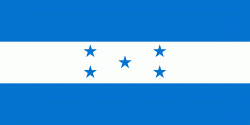El Paraíso Department (Departamento de El Paraíso)
El Paraíso is one of the 18 departments (departamentos) into which Honduras is divided.
The territory of El Paraíso was initially part of the departments of Tegucigalpa (renamed Francisco Morazán in 1943) and Olancho after Central America gained its independence in 1825. The department of El Paraíso was created with municipalities taken from the departments of Tegucigalpa and Olancho on 28 May 1869 by congressional decree in the third political division of Honduras, during the presidential term of José María Medina. Initially El Paraíso included the jurisdictions of Danlí, Yuscarán and Texiguat, along with the town of Guinope. On December 28, 1878, Texiguat was moved to the department of Tegucigalpa, but subsequently moved back into El Paraíso on October 28, 1886.
The departmental capital is Yuscarán. El Paraíso is bordered to the north by the department of Olancho, to the south by the department of de Choluteca, to the east by the Republic of Nicaragua, and to the west by the department of Francisco Morazán.
El Paraíso department covers a total surface area of 7489 km² and, in 2015, had an estimated population of 458,742.
* 1) Alauca
* 2) Danlí
* 3) El Paraíso
* 4) Guinope
* 5) Jacaleapa
* 6) Liure
The territory of El Paraíso was initially part of the departments of Tegucigalpa (renamed Francisco Morazán in 1943) and Olancho after Central America gained its independence in 1825. The department of El Paraíso was created with municipalities taken from the departments of Tegucigalpa and Olancho on 28 May 1869 by congressional decree in the third political division of Honduras, during the presidential term of José María Medina. Initially El Paraíso included the jurisdictions of Danlí, Yuscarán and Texiguat, along with the town of Guinope. On December 28, 1878, Texiguat was moved to the department of Tegucigalpa, but subsequently moved back into El Paraíso on October 28, 1886.
The departmental capital is Yuscarán. El Paraíso is bordered to the north by the department of Olancho, to the south by the department of de Choluteca, to the east by the Republic of Nicaragua, and to the west by the department of Francisco Morazán.
El Paraíso department covers a total surface area of 7489 km² and, in 2015, had an estimated population of 458,742.
* 1) Alauca
* 2) Danlí
* 3) El Paraíso
* 4) Guinope
* 5) Jacaleapa
* 6) Liure
Map - El Paraíso Department (Departamento de El Paraíso)
Map
Country - Honduras
 |
 |
| Flag of Honduras | |
Honduras was home to several important Mesoamerican cultures, most notably the Maya, before the Spanish colonization in the sixteenth century. The Spanish introduced Catholicism and the now predominant Spanish language, along with numerous customs that have blended with the indigenous culture. Honduras became independent in 1821 and has since been a republic, although it has consistently endured much social strife and political instability, and remains one of the poorest countries in the Western Hemisphere. In 1960, the northern part of what was the Mosquito Coast was transferred from Nicaragua to Honduras by the International Court of Justice.
Currency / Language
| ISO | Currency | Symbol | Significant figures |
|---|---|---|---|
| HNL | Honduran lempira | L | 2 |
| ISO | Language |
|---|---|
| ES | Spanish language |















